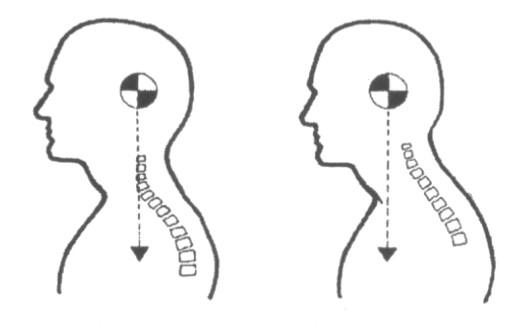Our bodies have ways of compensating no matter what we do to them. In my Anatomy and Physiology class they called this sensory adaptation. In other words, our bodies adapt to how we use them. Sometimes this is a great thing. Ask your muscles to do more, and they get stronger or build more endurance. Sometimes the adapt in ways that they shouldn't. Quit using them properly, and they quit working they way they were designed to work.
An example of what can change the posture of our upper bodies. (aka as the Head, Neck and Shoulder Complex)
What do I look at when deciding what I have a client work on when it comes to this part of their posture?
One being a forward head posture, which in a positive test involves the ear to move more than 3cm forward of the shoulder joint.

The second visual assessment is the position of the shoulders. The shoulders appear slumped or rounded forward, and there is a noticeable rounded appearance of the thoracic spine.

The third visual assessment shows the scapula to be winged and abducted. The normal position of the scapula is about 2-4 inches from the spine.

Certain muscles in the body tend to be prone
to becoming facilitated/tight, or inhibited/long and possibly weak. This is the
reason why certain muscle imbalance syndromes tend to be so common.
The muscles that tend to become short and hypertonic are the suboccipitals, upper trapezius, sternocleidomastoid, levator scapulae, pec minor, lats, and pec major. The muscles that tend to be inhibited or weak include the rhomboids, lower trapezius, serratus anterior, posterior deltoid, external rotator cuff, and the deep cervical flexors.
To correct this problem we must remind our clients to maintain a corrected postural alignment as often as possible. Cues such as "Pull your shoulders back", and "Tuck your chin back," will do well for starters. Have your client perform these corrections every hour on the hour, even when they perform their cardio exercise. Take advantage of correcting them while they are in the gym with you, because they may not do it on their own at home. Stretches should be emphasized on all of the tight muscles listed above prior to their workout.
The muscles that tend to become short and hypertonic are the suboccipitals, upper trapezius, sternocleidomastoid, levator scapulae, pec minor, lats, and pec major. The muscles that tend to be inhibited or weak include the rhomboids, lower trapezius, serratus anterior, posterior deltoid, external rotator cuff, and the deep cervical flexors.
To correct this problem we must remind our clients to maintain a corrected postural alignment as often as possible. Cues such as "Pull your shoulders back", and "Tuck your chin back," will do well for starters. Have your client perform these corrections every hour on the hour, even when they perform their cardio exercise. Take advantage of correcting them while they are in the gym with you, because they may not do it on their own at home. Stretches should be emphasized on all of the tight muscles listed above prior to their workout.
Exercises can also be added at the end of their routine to assist in strengthening the weaknesses.
Four exercises that I use frequently have my clients perform are:
Chin Tucks

The Hands Behind the Head Shoulder Blade Mobility

Standing
Shoulder Blade Squeezes with emphasis on scapular retraction, and depression.

Wall Slides


Wall Slides

For
the Hands behind the Head Shoulder Blade Mobility and the Chin Tucks, your goal is to eventually work your
clients up to 1-2 minute straight holds,
but to start, hold each for 30 seconds, then rest 15 seconds, and continue in
this manner until the client cannot hold for a full 30 seconds.
Other variations can be used for weaker or stronger clients. Shoulder Blade Squeezes should use a slow tempo and high reps if postural endurance is the goal.
Other variations can be used for weaker or stronger clients. Shoulder Blade Squeezes should use a slow tempo and high reps if postural endurance is the goal.

No comments:
Post a Comment